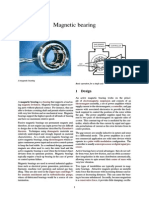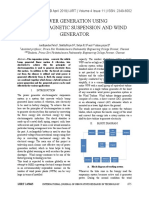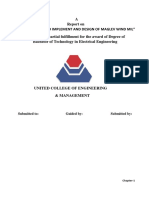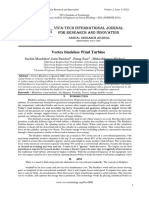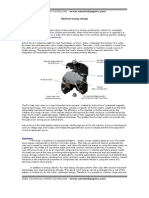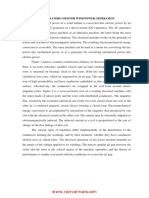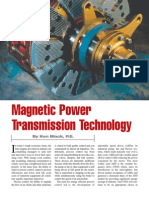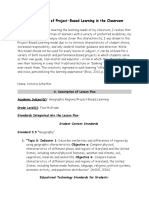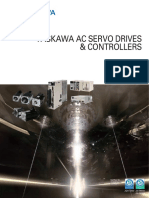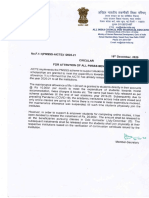Professional Documents
Culture Documents
Application of Efficiency Technology in EV Drive Systems and Regenerative Braking
Copyright
Available Formats
Share this document
Did you find this document useful?
Is this content inappropriate?
Report this DocumentCopyright:
Available Formats
Application of Efficiency Technology in EV Drive Systems and Regenerative Braking
Copyright:
Available Formats
Volume 7, Issue 6, June – 2022 International Journal of Innovative Science and Research Technology
ISSN No:-2456-2165
Application of Efficiency Technology in EV Drive
Systems and Regenerative Braking
Michael Anthony Stahl
Huntsville, Alabama, USA
Abstract: - Technology originally designed for efficiency modern power plants, as the rapid construction of entirely
and greenhouse gas emission reduction in commercial new facilities is often beyond the immediate available
power generation being utilized as an assist in efficiency funding of many utility providers.
in an electric vehicle. A mechanism, consisting of a
driving shaft composed of a non-ferrous alloy, with
planar magnetically charged beams, reacting with a set
of stationary magnets. Originally for installation within
the drive of a power plant, it facilitates the rotation of
the primary generators with greater torque and ease of
operation and may now be utilized in gaining efficiency
in electric vehicle power systems.
Keywords:- Driveshafts, Drives, Electric generators and
motors, Electric Power production, Electric Vehicle,
Regenerative braking.
I. INTRODUCTION
The consequences of the proliferation of Carbon
Dioxide and Sulphur Dioxide emissions in the earth’s Fig. 1: Point of device installation within power plant
atmosphere have been of major concern for decades, as
early as the 1960’s.[1] Automotive manufacturers are now Although originally conceived for use in fossil fuel
committed to achieving sustainability, not only in their and nuclear power plants, the concept may also be applied
products but also in how they are manufactured. [4] This in any method of electrical power production which
poses even greater challenges in technological employs rotation to generate an electrical field.
development, in how to produce world class, highly II. DESIGN AND OPERATION
advanced products while minimizing harm to the
environment,. This is especially challenging for any It consists of a tubular driving shaft, (Figure 2) forged
manufacturer, as while technological advancement can of 304 stainless steel (S30400) or other non-ferrous alloy.
move quickly, implementation within existing Over the center of the shaft are two elongated wheel
infrastructure is often difficult, if not totally economically sections, each containing a series of sixteen (16) vanes. The
impracticable. While a gradual shift is much more vanes form the channels into which are installed a series of
manageable, the rate of change currently desired, and even eight (8) magnetized strips. The strips are in themselves
stressed by governments and environmental concerns is far essentially bar magnets, each having a north and south
more drastic to implement. polar end accordingly and are installed in alternating order
around the perimeter of the shaft. Each strip is shaped with
In 2007 a Project was created to gain efficiency and a dovetail configuration which both assists in stability as
reduce emissions in traditional means of electric power well as functionality within their respective channels,
generation, and aid in the eventual transition from fossil creating the equilibrium necessary for rotation at high
fuels to alternative forms of energy production, specifically speeds. Near the poles of each strip are eight (8) stationary
in the generation of electricity by fossil fuel. A magnets which react with the shaft. At any given moment
magnetically assisted generator shaft was designed to during.operation. The strips are being attracted by one of
function as a link, specifically at the point where the the stationary magnets, yet also repelled by half of the force
generated torque is delivered from the turbine drive to the of each of the surrounding two strips on either side (figure
main series of generators within a power plant. (Figure 1) 3) They are rated at the same charge or pull load and flux
This providing an estimated 15 to 25% gain in efficiency density as those on the shaft, creating a necessary balance
with a likewise percentage in emissions reduction. In turn, of constant magnetic attractions and reactions.
this also lowers the production cost of each kilowatt per
hour to the producer. It is this assistance that enables the ease of the rotation
as the reactions of the stationary magnets with the
The device is applied within established means of magnetized strips produce the effect of a virtual “cradle” or
electric energy production, installed with an absolute balance of forces for the shaft to rotate within, similar to
minimum of cost in exchange for the benefits received. the action of a magnetic bearing. The device, in pseudo-
This is especially helpful in areas serviced by relatively levitation by mechanical constraint, regardless of its size
IJISRT22JUN1501 www.ijisrt.com 1582
Volume 7, Issue 6, June – 2022 International Journal of Innovative Science and Research Technology
ISSN No:-2456-2165
and weight is now enabled to move in a far more weightless In addition to these attributes, implementation of the
state with extremely low friction. Hence, this allows the device results in another benefit. In operation, the action
entire assembly to be moved with greatly increased produced by the shaft itself may also be employed as a
moment of force than would normally be possible. means of electrical power generation. As a commercial
Although Earnshaw's theorem does not allow for a static generator typically contains a powerful magnet which
configuration of permanent magnets to stably levitate produces an electric field, in operation, a series of wires are
another permanent magnet or materials that are rotated through this field which produces electrical current.
paramagnetic or ferromagnetic against gravity,[7] the The magnetized strips reacting with the stationary magnets
theorem does not apply to the non-static nature of the produce the same kind of reciprocation as in the
device. commercial generator with very similar end results. In this
case, the shaft during rotation also produces a magnetic
field in a method like that of the stator within the typical
commercial generator. While the magnet within the
generator is stationary with wires rotating through the field,
the magnetized strips in rotation produce a magnetic field
surrounding the shaft during operation. It is this field which
may be additionally utilized in the production of electricity.
A series of cage-type structures composed of
conductive wires will employ this added source of
electrical current. When installed surrounding the device
while in operation, the stationary wires will assimilate
current produced by their reaction with the magnetic field
produced by the shaft. This energy may then be stored or
used immediately for whatever purpose desired. The
additional current may even be deployed to partially
Fig. 2: Configuration of driving shaft facilitate the rotation of the shaft itself. This may be
achieved through an electric assist mechanism, such as a
For our illustration we will take a plant operating at series of motors. Thus, in essence, the energy produced by
50% production rate. To operate at this level, a given the shaft can also become a partial energy source to power
amount of fuel must be burned to produce enough steam to it, resulting in even greater operating efficiency.
rotate the turbine at the desired rate. The speed of the
turbine is determined by the quantity of fuel burned, which The Project was accepted to Clean Energy, NM, (Now
of course directly or indirectly regulates the speed of the New Mexico Renewable Energy Transmission
operation of the generators. Installation of this device Authority), by the New Mexico State Governor’s Office.
enables this plant to operate at the previous rate, yet with The original technical proposal StahlCon 7: Magnetically
improved productivity. A plant running at a normal 50% Assisted Generator Shaft for Use in Fossil Fuel and Nuclear
rate will now produce the amount of electricity as if Energy Production. was published on July 7, 2007, and
operating previously at a 65% to 70% rate. This is made shared with the governments of both Canada and Great
possible by the reduction in drag between the primary Britain, and the Alliance to Save Energy in Washington
turbine drive and the generators. As the mass of the shaft is D.C. [2] [6]
now free to operate within the field created by the reaction
III. CONCLUSION
of the magnetized strips with the stationary magnets. Thus,
the mass of the shaft may drive the generators with far less The basic concept of this technology could be utilized
resistance and greater torque, resulting in greater efficiency. by automobile manufacturers in two ways. It could be
employed as originally designed in increasing efficiency
and reducing operational emissions at plants where
practical, especially at operations where facilities may
produce, supplement, or store some of their own power.
There is also a definite possibility that this concept
could also have automotive applications, functioning as an
assist to a main power source in an electric vehicle, and/or
being utilized in its regenerative braking system. Since an
electric vehicle’s motor can reverse itself to function as a
generator during deceleration, the controllers on most
electric vehicles also have a system, whereby some of the
kinetic energy normally absorbed by the brakes and turned
into heat is converted to electricity by the motor/controller
and is used to re-charge the batteries. A miniaturized
Fig. 3: Shaft at given moment during operation
version of this basic type of shaft could function as a
IJISRT22JUN1501 www.ijisrt.com 1583
Volume 7, Issue 6, June – 2022 International Journal of Innovative Science and Research Technology
ISSN No:-2456-2165
component of an axle or drive assembly in an EV. While [5.] Komatsu, Yasuhiro, Shiga (Japan) MAGNETIC
weight displacement would not be as primary a concern in ROTATION DEVICE, Patent Application No.
an electric automotive application as it would in an internal WO2011114982A1 Date of Publication September
combustion vehicle, or even within commercial power 22, 2011
generation with this concept, the efficiency of the braking [6.] Marshall, Hazell. Environmental Nanotechnology
system to generate electrical energy during deceleration (Ed-Tech Press, 2018, p. 58)
could be greatly improved. Regenerative braking generally [7.] Simon, Martin D.; Heflinger, Lee O.; Ridgway, S. L.
not only increases the range of an electric vehicle by 5 - (1997). "Spin stabilized magnetic levitation".
10%, but also decreases brake wear and reduces American Journal of Physics. American Association
maintenance cost. [3] of Physics Teachers (AAPT). 65 (4): 286–292.
doi:10.1119/1.18488. ISSN 0002-9505. Retrieved
2006-12-06.
[8.] Stahl, Michael Anthony, Huntsville, AL (US)
MAGNETICALLY ASSISTED GENERATOR
SHAFT, Patent No. US D539,739 S Date of Patent
April 3, 2007.
Fig. 4: Magnetic Rotation Device
The shaft’s main design resulted in US Patent
D539,739 Magnetically assisted generator shaft,.[8] which
was issued on April 3, 2007.Japanese Patent JP5540411B2
Magnetic Rotation Device granted in 2010 and
International Application WO 2011114982A1 (Figure 4)
filed in 2011[5] disclose a later, very similar concept in
which alternating current flowed briefly through
electromagnets to assist in the rotation of the device,
essentially resulting in an electronic process called pulse
width modulation. All patents foreign and domestic have
expired, and the technology described herein is now
available for use in the public domain.
REFERENCES
[1.] Auchincloss, Kenneth “The Ravaged Environment”,
Newsweek, January 26, 1970. P.40
[2.] Deyab, Asma Fouad Mohammed Abdulhalem, titled
as “An Effective Climate Change and Renewable
Policies and Regulations: Scheming Competitive and
Sustainable Green Energy Environment” International
Journal of Innovative Science and Research
Technology, (IJISRT) Volume 4, Issue 3, March
2019. P. 801
[3.] EV Power Systems (Motors and controllers)
Advanced Vehicle Testing Activity, Idaho National
Laboratory. [online] Available
https://avt.inl.gov/sites/default/files/pdf/fsev/power.pd
f p.3
[4.] General Motors Company Annual Report 2016,
Environmental and Regulatory Matters Part 1, p. 6.
IJISRT22JUN1501 www.ijisrt.com 1584
You might also like
- Introduction, Concepts, Scope of Community Health NursingDocument32 pagesIntroduction, Concepts, Scope of Community Health Nursingmuthukumar82% (28)
- Guidelines For The Design and Construction of Suspension FootbridgesDocument141 pagesGuidelines For The Design and Construction of Suspension Footbridgesjavali2100% (2)
- Elastic energy-recycling actuators for efficient robots-Document10 pagesElastic energy-recycling actuators for efficient robots-Hongwei BaiNo ratings yet
- Study of a reluctance magnetic gearbox for energy storage system applicationFrom EverandStudy of a reluctance magnetic gearbox for energy storage system applicationRating: 1 out of 5 stars1/5 (1)
- A Quick Guide To The FMD Pro PDFDocument24 pagesA Quick Guide To The FMD Pro PDFstouraNo ratings yet
- Online Auction SystemDocument29 pagesOnline Auction SystemDharmendra83% (6)
- Microsoft Test4prep AI-900 v2020-09-07 by Abdullah 25qDocument19 pagesMicrosoft Test4prep AI-900 v2020-09-07 by Abdullah 25qANIMESH301No ratings yet
- Lay Up ProcedureDocument21 pagesLay Up ProcedureAmir100% (1)
- Frictionless Electricity Generation Using Propeller Shaft: ISSN: 2454-132X Impact Factor: 6.078Document6 pagesFrictionless Electricity Generation Using Propeller Shaft: ISSN: 2454-132X Impact Factor: 6.078Raja ManeNo ratings yet
- Magnetic BearingDocument5 pagesMagnetic BearingKarthiLoganNo ratings yet
- Maglev Wind Mill ReportDocument24 pagesMaglev Wind Mill ReportBalu MahendarNo ratings yet
- ProjectDocument16 pagesProjectpothugunta charanNo ratings yet
- Multi Rotor Wind Mill Power Generation: AbstractDocument32 pagesMulti Rotor Wind Mill Power Generation: AbstractAnonymous j0aO95fgNo ratings yet
- Small Power Generation Vertical Axis Wind Turbine (VAWT) SystemDocument3 pagesSmall Power Generation Vertical Axis Wind Turbine (VAWT) SystemDhika WidayanaNo ratings yet
- Maglev Wind TurbineDocument22 pagesMaglev Wind TurbineNikhil Kumar100% (1)
- 21-26 EngDocument6 pages21-26 EngVaibhav SanNo ratings yet
- Study On Magnetic Levitation For Vertical Axis Wind Turbine and Low Wind SpeedDocument6 pagesStudy On Magnetic Levitation For Vertical Axis Wind Turbine and Low Wind SpeedIJSTENo ratings yet
- Maglev Wind TurbineDocument6 pagesMaglev Wind TurbineDIWAKAR MRNo ratings yet
- A Novel Axial Air-Gap Transverse Flux Switching PMDocument12 pagesA Novel Axial Air-Gap Transverse Flux Switching PMh.nagarjaNo ratings yet
- Keysan 2015 Supercond. Sci. Technol. 28 034004Document11 pagesKeysan 2015 Supercond. Sci. Technol. 28 034004DawoodNo ratings yet
- Power Generation Using Electromagnetic Suspension and Wind GeneratorDocument4 pagesPower Generation Using Electromagnetic Suspension and Wind GeneratorHarshathNo ratings yet
- 1 Group - 10366 - Manuscript (IEEE Format)Document8 pages1 Group - 10366 - Manuscript (IEEE Format)Al MahinayNo ratings yet
- Research Paper14Document6 pagesResearch Paper14mangla bhullarNo ratings yet
- Abhay ReportDocument46 pagesAbhay ReportAnuj TripathiNo ratings yet
- A Study of Power Formers and Their Impact On Power System Reliability and EnvironmentDocument9 pagesA Study of Power Formers and Their Impact On Power System Reliability and EnvironmentdhcpNo ratings yet
- Soft Starter Investigation On Grid Connection of Wind TurbinesDocument8 pagesSoft Starter Investigation On Grid Connection of Wind TurbinesPradip KhatriNo ratings yet
- Power Generation Using Vehicle Suspension: July 2018Document4 pagesPower Generation Using Vehicle Suspension: July 2018Kiran PatilNo ratings yet
- The Renewable Energy in A Led Standalone StreetlightDocument12 pagesThe Renewable Energy in A Led Standalone StreetlightMarianoLuisPérezPortocarreroNo ratings yet
- Wind GeneratorDocument4 pagesWind GeneratorSara VananNo ratings yet
- Irjet V4i2404 PDFDocument3 pagesIrjet V4i2404 PDFdpksobsNo ratings yet
- Performance Analysis SPFHPUMotorDocument7 pagesPerformance Analysis SPFHPUMotorTiến BìnhPeanutNo ratings yet
- Powerformers' Impact on Reliability and the EnvironmentDocument8 pagesPowerformers' Impact on Reliability and the EnvironmentPNo ratings yet
- Magnetic Levitation Wind TurbineDocument12 pagesMagnetic Levitation Wind TurbineBiniyamNo ratings yet
- Brushless and Permanent Magnet Free Wound Field Synchronous Motors For EV TractionDocument51 pagesBrushless and Permanent Magnet Free Wound Field Synchronous Motors For EV TractionSurajit SahaNo ratings yet
- Icietet 118Document5 pagesIcietet 118David RiosNo ratings yet
- A New Concentrated Windings Surface Mounted Permanent Magnet Synchronous Machine For Wind Energy ApplicationDocument6 pagesA New Concentrated Windings Surface Mounted Permanent Magnet Synchronous Machine For Wind Energy Applicationwalidghoneim1970No ratings yet
- Detailed Project Report (DPR) For 2.7 MW Power Plant Burjesia Area (Basra, Iraq)Document24 pagesDetailed Project Report (DPR) For 2.7 MW Power Plant Burjesia Area (Basra, Iraq)hardikNo ratings yet
- 63 554173 PDFDocument9 pages63 554173 PDFCastañeda ValeriaNo ratings yet
- Harvesting Vibration Energy by Electromagnetic Induction: Robert GHERCĂ, Radu OLARUDocument6 pagesHarvesting Vibration Energy by Electromagnetic Induction: Robert GHERCĂ, Radu OLARUSara TehraniNo ratings yet
- Free Energy GeneratorDocument9 pagesFree Energy GeneratorSridhar PatilNo ratings yet
- Suspended Frictionless Windmill: Presentation OnDocument17 pagesSuspended Frictionless Windmill: Presentation OnShri PatilNo ratings yet
- Design and Fabrication of Rotary Silica Sand Sieving Machine With Solar Based PowerDocument26 pagesDesign and Fabrication of Rotary Silica Sand Sieving Machine With Solar Based PowerChristine SaliganNo ratings yet
- International Journal of Research Publication and ReviewsDocument3 pagesInternational Journal of Research Publication and ReviewsIan DimayugaNo ratings yet
- Vortex Bladeless Wind TurbineDocument4 pagesVortex Bladeless Wind TurbineVIVA-TECH IJRINo ratings yet
- Flywheel Energy StorageDocument2 pagesFlywheel Energy Storagehayat umar bhatNo ratings yet
- Superconducting Super Motor and Generator: Minaru Kawamura, and Jonathan A. JonesDocument5 pagesSuperconducting Super Motor and Generator: Minaru Kawamura, and Jonathan A. JonesAnudeep AnasuriNo ratings yet
- IJSRDV6I50382Document4 pagesIJSRDV6I50382asborade04No ratings yet
- Wind Power Plant Using Magnetic Levitation Wind Turbine: ISO 9001:2008 CertifiedDocument3 pagesWind Power Plant Using Magnetic Levitation Wind Turbine: ISO 9001:2008 CertifiedrendraNo ratings yet
- Aggregated Wind Park Models For Analyzing Power System DynamicsDocument10 pagesAggregated Wind Park Models For Analyzing Power System Dynamicsmohamed faisalNo ratings yet
- Synchronverters: Inverters That Mimic Synchronous GeneratorsDocument9 pagesSynchronverters: Inverters That Mimic Synchronous GeneratorsqhuncepuNo ratings yet
- Design and Manufacture Issues of A 100 000 RPM Micro-Turbine Electric Generator SystemDocument7 pagesDesign and Manufacture Issues of A 100 000 RPM Micro-Turbine Electric Generator SystemGiovanni GiudiceNo ratings yet
- Large Photovoltaic Power Plant Design: ResearchDocument9 pagesLarge Photovoltaic Power Plant Design: ResearchMardi RahardjoNo ratings yet
- Permanent Magnet Synchronous Generator For Wind-Power GenerationDocument6 pagesPermanent Magnet Synchronous Generator For Wind-Power GenerationPradip KhatriNo ratings yet
- Aspden - Power From Magnetism - Over-Unity Motor Design (1996)Document31 pagesAspden - Power From Magnetism - Over-Unity Motor Design (1996)Fried M. KhanNo ratings yet
- Electrical Generators PDFDocument71 pagesElectrical Generators PDFchaithra hsNo ratings yet
- Generating Electricity from Vehicle Shock AbsorbersDocument12 pagesGenerating Electricity from Vehicle Shock AbsorberssagarNo ratings yet
- IJSRD - International Journal for Scientific Research & Development| Vol. 5, Issue 02, 2017 | ISSN (online): 2321-0613Document4 pagesIJSRD - International Journal for Scientific Research & Development| Vol. 5, Issue 02, 2017 | ISSN (online): 2321-0613rock starNo ratings yet
- Performance of Wind Turbine With Magnetic LevitationDocument8 pagesPerformance of Wind Turbine With Magnetic LevitationIJRASETPublicationsNo ratings yet
- A Coaxial Magnetic Gearbox With Magnetic Levitation CapabilitiesDocument7 pagesA Coaxial Magnetic Gearbox With Magnetic Levitation CapabilitiesnevesunipampaNo ratings yet
- Power Generation by Foot Step Method - Rack and PinionDocument13 pagesPower Generation by Foot Step Method - Rack and Pinionprem53100% (2)
- Electrical Line Article - April 2003Document5 pagesElectrical Line Article - April 2003rakeshwani123No ratings yet
- Power Generation Using Vehicle SuspensionDocument3 pagesPower Generation Using Vehicle SuspensionAnonymous 83DtcmB1nGNo ratings yet
- Electricity Power Generation Through Magnetic Couplings Index Sr. No. Content Page NoDocument72 pagesElectricity Power Generation Through Magnetic Couplings Index Sr. No. Content Page Noakshay jadhavNo ratings yet
- An Analysis on Mental Health Issues among IndividualsDocument6 pagesAn Analysis on Mental Health Issues among IndividualsInternational Journal of Innovative Science and Research TechnologyNo ratings yet
- Harnessing Open Innovation for Translating Global Languages into Indian LanuagesDocument7 pagesHarnessing Open Innovation for Translating Global Languages into Indian LanuagesInternational Journal of Innovative Science and Research TechnologyNo ratings yet
- Diabetic Retinopathy Stage Detection Using CNN and Inception V3Document9 pagesDiabetic Retinopathy Stage Detection Using CNN and Inception V3International Journal of Innovative Science and Research TechnologyNo ratings yet
- Investigating Factors Influencing Employee Absenteeism: A Case Study of Secondary Schools in MuscatDocument16 pagesInvestigating Factors Influencing Employee Absenteeism: A Case Study of Secondary Schools in MuscatInternational Journal of Innovative Science and Research TechnologyNo ratings yet
- Exploring the Molecular Docking Interactions between the Polyherbal Formulation Ibadhychooranam and Human Aldose Reductase Enzyme as a Novel Approach for Investigating its Potential Efficacy in Management of CataractDocument7 pagesExploring the Molecular Docking Interactions between the Polyherbal Formulation Ibadhychooranam and Human Aldose Reductase Enzyme as a Novel Approach for Investigating its Potential Efficacy in Management of CataractInternational Journal of Innovative Science and Research TechnologyNo ratings yet
- The Making of Object Recognition Eyeglasses for the Visually Impaired using Image AIDocument6 pagesThe Making of Object Recognition Eyeglasses for the Visually Impaired using Image AIInternational Journal of Innovative Science and Research TechnologyNo ratings yet
- The Relationship between Teacher Reflective Practice and Students Engagement in the Public Elementary SchoolDocument31 pagesThe Relationship between Teacher Reflective Practice and Students Engagement in the Public Elementary SchoolInternational Journal of Innovative Science and Research TechnologyNo ratings yet
- Dense Wavelength Division Multiplexing (DWDM) in IT Networks: A Leap Beyond Synchronous Digital Hierarchy (SDH)Document2 pagesDense Wavelength Division Multiplexing (DWDM) in IT Networks: A Leap Beyond Synchronous Digital Hierarchy (SDH)International Journal of Innovative Science and Research TechnologyNo ratings yet
- Comparatively Design and Analyze Elevated Rectangular Water Reservoir with and without Bracing for Different Stagging HeightDocument4 pagesComparatively Design and Analyze Elevated Rectangular Water Reservoir with and without Bracing for Different Stagging HeightInternational Journal of Innovative Science and Research TechnologyNo ratings yet
- The Impact of Digital Marketing Dimensions on Customer SatisfactionDocument6 pagesThe Impact of Digital Marketing Dimensions on Customer SatisfactionInternational Journal of Innovative Science and Research TechnologyNo ratings yet
- Electro-Optics Properties of Intact Cocoa Beans based on Near Infrared TechnologyDocument7 pagesElectro-Optics Properties of Intact Cocoa Beans based on Near Infrared TechnologyInternational Journal of Innovative Science and Research TechnologyNo ratings yet
- Formulation and Evaluation of Poly Herbal Body ScrubDocument6 pagesFormulation and Evaluation of Poly Herbal Body ScrubInternational Journal of Innovative Science and Research TechnologyNo ratings yet
- Advancing Healthcare Predictions: Harnessing Machine Learning for Accurate Health Index PrognosisDocument8 pagesAdvancing Healthcare Predictions: Harnessing Machine Learning for Accurate Health Index PrognosisInternational Journal of Innovative Science and Research TechnologyNo ratings yet
- The Utilization of Date Palm (Phoenix dactylifera) Leaf Fiber as a Main Component in Making an Improvised Water FilterDocument11 pagesThe Utilization of Date Palm (Phoenix dactylifera) Leaf Fiber as a Main Component in Making an Improvised Water FilterInternational Journal of Innovative Science and Research TechnologyNo ratings yet
- Cyberbullying: Legal and Ethical Implications, Challenges and Opportunities for Policy DevelopmentDocument7 pagesCyberbullying: Legal and Ethical Implications, Challenges and Opportunities for Policy DevelopmentInternational Journal of Innovative Science and Research TechnologyNo ratings yet
- Auto Encoder Driven Hybrid Pipelines for Image Deblurring using NAFNETDocument6 pagesAuto Encoder Driven Hybrid Pipelines for Image Deblurring using NAFNETInternational Journal of Innovative Science and Research TechnologyNo ratings yet
- Terracing as an Old-Style Scheme of Soil Water Preservation in Djingliya-Mandara Mountains- CameroonDocument14 pagesTerracing as an Old-Style Scheme of Soil Water Preservation in Djingliya-Mandara Mountains- CameroonInternational Journal of Innovative Science and Research TechnologyNo ratings yet
- A Survey of the Plastic Waste used in Paving BlocksDocument4 pagesA Survey of the Plastic Waste used in Paving BlocksInternational Journal of Innovative Science and Research TechnologyNo ratings yet
- Hepatic Portovenous Gas in a Young MaleDocument2 pagesHepatic Portovenous Gas in a Young MaleInternational Journal of Innovative Science and Research TechnologyNo ratings yet
- Design, Development and Evaluation of Methi-Shikakai Herbal ShampooDocument8 pagesDesign, Development and Evaluation of Methi-Shikakai Herbal ShampooInternational Journal of Innovative Science and Research Technology100% (3)
- Explorning the Role of Machine Learning in Enhancing Cloud SecurityDocument5 pagesExplorning the Role of Machine Learning in Enhancing Cloud SecurityInternational Journal of Innovative Science and Research TechnologyNo ratings yet
- A Review: Pink Eye Outbreak in IndiaDocument3 pagesA Review: Pink Eye Outbreak in IndiaInternational Journal of Innovative Science and Research TechnologyNo ratings yet
- Automatic Power Factor ControllerDocument4 pagesAutomatic Power Factor ControllerInternational Journal of Innovative Science and Research TechnologyNo ratings yet
- Review of Biomechanics in Footwear Design and Development: An Exploration of Key Concepts and InnovationsDocument5 pagesReview of Biomechanics in Footwear Design and Development: An Exploration of Key Concepts and InnovationsInternational Journal of Innovative Science and Research TechnologyNo ratings yet
- Mobile Distractions among Adolescents: Impact on Learning in the Aftermath of COVID-19 in IndiaDocument2 pagesMobile Distractions among Adolescents: Impact on Learning in the Aftermath of COVID-19 in IndiaInternational Journal of Innovative Science and Research TechnologyNo ratings yet
- Studying the Situation and Proposing Some Basic Solutions to Improve Psychological Harmony Between Managerial Staff and Students of Medical Universities in Hanoi AreaDocument5 pagesStudying the Situation and Proposing Some Basic Solutions to Improve Psychological Harmony Between Managerial Staff and Students of Medical Universities in Hanoi AreaInternational Journal of Innovative Science and Research TechnologyNo ratings yet
- Navigating Digitalization: AHP Insights for SMEs' Strategic TransformationDocument11 pagesNavigating Digitalization: AHP Insights for SMEs' Strategic TransformationInternational Journal of Innovative Science and Research Technology100% (1)
- Drug Dosage Control System Using Reinforcement LearningDocument8 pagesDrug Dosage Control System Using Reinforcement LearningInternational Journal of Innovative Science and Research TechnologyNo ratings yet
- The Effect of Time Variables as Predictors of Senior Secondary School Students' Mathematical Performance Department of Mathematics Education Freetown PolytechnicDocument7 pagesThe Effect of Time Variables as Predictors of Senior Secondary School Students' Mathematical Performance Department of Mathematics Education Freetown PolytechnicInternational Journal of Innovative Science and Research TechnologyNo ratings yet
- Formation of New Technology in Automated Highway System in Peripheral HighwayDocument6 pagesFormation of New Technology in Automated Highway System in Peripheral HighwayInternational Journal of Innovative Science and Research TechnologyNo ratings yet
- English For Academic and Professional Purposes: Quarter 1 - Module 3Document9 pagesEnglish For Academic and Professional Purposes: Quarter 1 - Module 3John Vincent Salmasan100% (5)
- Project-Based Learning Lesson PlanDocument5 pagesProject-Based Learning Lesson Planapi-324732071100% (1)
- Empowerment Technologies Week 1-2 - Final Term: Prepared By: Mr. Jake Indico Edited By: Ms. Shaira G. RaquilDocument5 pagesEmpowerment Technologies Week 1-2 - Final Term: Prepared By: Mr. Jake Indico Edited By: Ms. Shaira G. RaquilJustine Evasco RubiaNo ratings yet
- Home Work Chapter 1 To 12Document50 pagesHome Work Chapter 1 To 12Haha JohnNgNo ratings yet
- Group 3 - Brand Architecture Assignment IDocument9 pagesGroup 3 - Brand Architecture Assignment IShijin SreekumarNo ratings yet
- Welding Cost Optimization with GMAWDocument6 pagesWelding Cost Optimization with GMAWratneshkumar2004No ratings yet
- Esp Module 4Document34 pagesEsp Module 4ELLEN B.SINAHONNo ratings yet
- Understanding Data GovernanceDocument28 pagesUnderstanding Data GovernanceJoe leninja100% (1)
- Radiant Heating and Cooling SystemDocument8 pagesRadiant Heating and Cooling SystemLaurentiuNo ratings yet
- Ha16 18PXDocument2 pagesHa16 18PXStefce PetrovNo ratings yet
- Signed-Off Komunikasyon-at-Pananaliksik11 q1 m2 - Konseptong-Pangwika v3 PDFDocument24 pagesSigned-Off Komunikasyon-at-Pananaliksik11 q1 m2 - Konseptong-Pangwika v3 PDFChristian Ocon100% (1)
- Yaskawa Ac Servo Drives & Controllers PDFDocument40 pagesYaskawa Ac Servo Drives & Controllers PDFNur CholisNo ratings yet
- Project Report ON: "Brand Preference of Onida Colour TV in Coastal OrissaDocument66 pagesProject Report ON: "Brand Preference of Onida Colour TV in Coastal OrissaApurba KhanduriNo ratings yet
- AICTE NoticeDocument1 pageAICTE NoticeThe WireNo ratings yet
- Module 2 Backbencher - ClubDocument16 pagesModule 2 Backbencher - ClubH shashidhar ReddyNo ratings yet
- Hello World in FortranDocument43 pagesHello World in Fortranhussein alsaedeNo ratings yet
- Newspaper Layout DummyDocument1 pageNewspaper Layout Dummy1w2e3r4t5y100% (9)
- Quiz II - Company MissionDocument4 pagesQuiz II - Company MissionSuraj SapkotaNo ratings yet
- Revised Circular On Secretariat Meeting Held On 9th July, 2023Document4 pagesRevised Circular On Secretariat Meeting Held On 9th July, 2023Mohit SoniNo ratings yet
- Mobile Scaffold Inspection ChecklistDocument3 pagesMobile Scaffold Inspection Checklistanthony murphyNo ratings yet
- Motor Vehicles and Road Traffic Regulation 48.50Document411 pagesMotor Vehicles and Road Traffic Regulation 48.50Clayton AllenNo ratings yet
- Anchor ChairDocument3 pagesAnchor ChairrsubramaniNo ratings yet
- ASME B16: Standardization of Valves, Flanges, Fittings, and Gaskets # Standard DesignationDocument6 pagesASME B16: Standardization of Valves, Flanges, Fittings, and Gaskets # Standard DesignationNicolás MerinoNo ratings yet
- Contoh Kurikulum Vitae PDFDocument8 pagesContoh Kurikulum Vitae PDFANDI2lusNo ratings yet











